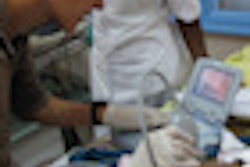
Ultrasound still appears to be used widely throughout India to facilitate sex-selective abortions, despite ongoing national efforts to prevent this illegal practice. Seventeen years after implementation of the Pre-Conception (PC) and Pre-Natal Diagnostic Techniques (PNDT) Act, observers claim legislation has failed to reduce the numbers of sex-selective abortions, and inconsistency in regional application penalizes innocent mistakes, while allowing the real offenders to get away with feticide.
In response, the Indian Radiological and Imaging Association (IRIA) is driving forward a petition to underpin the aims of the PNDT Act while protecting radiologists from heavy-handed interpretations of the law.
A new study in Lancet (4 June 2011, Vol. 377:9781, pp. 1921-1928) suggests female feticide is still very common in India and estimates between 4.2 million and 12.1 million female fetuses have been aborted since 1980. Although the decline in female child sex ratios was sharper in the 1990s, it remains in decline, the interpretation being that selective abortions of girls have increased, particularly after a firstborn girl.
Furthermore, the latest census figures announced in April show that the national child sex ratio is at 914 girls between the ages of 0 to 6 years old per 1000 boys, the lowest since independence and down from the last census ratio of 927 in 2001. The skewed figures have led to a prompt amendment in the PNDT act to allow the seizure of all unregistered ultrasound machines, with some local governments increasing reward money for whistle blowers.
At present, the act facilitates stringent monitoring of machines, exams, and Form F which documents fetal imaging. Legal action ranging from fines to the sealing of centers may result from clerical errors, with proven abuse of sex-determination tests carrying prison sentences. There seems to be an inconsistent approach to how monitoring is carried out.
 The main root of the problem is the persistence of gender inequality, according to Dr. Himanshu Vadodaria.
The main root of the problem is the persistence of gender inequality, according to Dr. Himanshu Vadodaria.
"Action is being taken but not in an optimal or systematic manner," said Dr. Himanshu Vadodaria, a radiologist at Hanumant Trust Hospital in Bhavnagar, Gujarat. "Fellow radiologists in the eastern states tell me that they don't have their practices checked that much or that regularly, compared to clinics in Gujarat where officials strictly and regularly check ultrasound clinics."
There are also differences in approach: A small amount of data missing from a form may result in an automatic legal warning, but with the chance for errors to be rectified in a set time frame. Alternatively it may result in the confiscation of a machine, a fine, or the closure of an entire center, according to doctors' personal accounts.
Also varying to large degrees are interpretations of requirements by officials: Describing themselves as "tired of the high-handedness" of collectors and magistrates in their district, members of the Maharashtra chapter of the IRIA (MSBIRIA) have filed a case to be heard in court later this month against the collector of Kolhapur. In his capacity as the appropriate authority, the magistrate is alleged to have tried to force doctors to become involved in a private pilot project, using costly hardware and software to allow the collector "observatory access" to all scanned images, as well as oblige doctors to submit Form F online to a private non-governmental website.
"Neither of these measures are legal under the PC-PNDT Act, the former potentially breaching patient confidentiality and legal rules, and the latter impossible given that Form F requires physical signatures," said Dr. Jignesh Thakker, general secretary and national PC-PNDT co-ordinator of IRIA. "And why wasn't the so-called pilot scheme sponsored by government?" he asked.
 India's ultrasound clinics must be in the hands of medically qualified specialists, according to Dr. Jignesh Thakker general secretary of IRIA.
India's ultrasound clinics must be in the hands of medically qualified specialists, according to Dr. Jignesh Thakker general secretary of IRIA.
According to Thakker, evidence of harassment and of the act's overall lack of impact on sex ratios has mounted to such an extent that in May IRIA filed a petition with the Supreme Court, calling for a writ to ensure consistent application of the law nationwide.
"The hearing is yet to be given a date, but the petition aims to strengthen the PNDT act through its proposals for ultrasound and genetic counseling clinics to only be run by those who are appropriately qualified -- currently not the case," he said. "Radiologists should also be among the panel of experts advising on amendments to the act or measures to apply and enforce it. Officials should be trained to do their job without harassing radiology experts," he added.
A senior radiologist who did not wish to be named pointed to the damage caused to the reputation of a doctor and practice when a center was sealed, citing a raid on 100 centers which resulted in a three-day shutdown with half the centers' doctors named in the newspapers.
"In India clinics are local. Clients generally come from a 2-km radius and any slurs circulate very quickly," he said.
"As the government can't stop female feticide it has to be seen to be doing something and is going after the soft targets. What can we do if officials shut us down? Nothing -- just appear humble and wait. We need to catch those performing feticide, not those that diagnose a baby's sex."
The 2011 census supports the interpretation in the Lancet study, even showing sex ratios in many states way below the national average, now at an all-time low. In Rajasthan, the ratio has dropped to 883, down from 909 in 2001. In Gujarat the current ratio is 886, slightly up from 883 in the 1990s but still far lower than the ratio of 928 in the 1980s. Meanwhile, strong implementation of the act in the Kangra district of Himachal Pradesh means that the latest sex ratio there has risen to 968 girls per 1000 boys, from 948 in 2001.
 Adverts like these are being used to help educate people throughout India, but doubt remains about their effectiveness. Image courtesy of www.indiafemalefoeticide.org.
Adverts like these are being used to help educate people throughout India, but doubt remains about their effectiveness. Image courtesy of www.indiafemalefoeticide.org.Sex-selective abortion is considered to be far less widespread among the richer and more educated sectors of society that may value the role and contribution of women in and to society more than poorer, less-educated sectors.
However, the census figures show it is not the poorest areas that have the lowest ratio figures. The sheer cost of an illegal imaging procedure estimated at between 10 to 20 times that of a standard procedure puts it beyond the scope of the poor and firmly in the hands of India's growing middle classes. Even so, India's illicit business looks set to lose market share as patients increasingly choose to travel overseas in the future.
"I'm surprised any relatively well-off patients would pay between $1,000 to $2,000 for an illegal imaging procedure in India when the whole process can be undertaken more cheaply and legally abroad," the radiologist said, pointing to the legal and at times "cheaper" option of traveling to Dubai or Singapore from India.
For their part, doctors bringing home an average $1,500 to $3,000 per month, depending on whether they work in the public or private sector, the prospect of extra money earned this way may seem tempting, if fraught with risk.
Despite the danger of being caught and the expense involved for patients, the stick end of the dynamic does not seem enough of a deterrent. On the whole, public awareness is growing due to advertising campaigns on TV, at cinemas, billboards, and at bus stops, according to Vadodaria. However, the long-term economic and social benefits of a more balanced sex ratio do not yet appear to be a visible enough "carrot."
The main root of the problem is the persistence of gender inequality. Female children in many states still don't receive a full education, leaving school at the age of 10, and sometimes married by the age of 15, despite the fact that 18 is the legal minimum for women, Vadodaria explained.
Doctors suggest it will take two or three more generations for attitudes to change in India regarding the birth of female children, and this will be more due to emancipation through ongoing education rather than affluence alone.



















